
「これ、全部、私が作ったの。」
= Kore, zenbu, watashi ga tsukutta no.
= I made all of these, you know.
(もちろん、うそだけど)
= Mochiron, uso dakedo.
= (Of course it’s not true though…)
「すご〜い!」
= Sugoooi!
= Wooow!
(バレバレだけど..)
= Barebare dakedo…
= (It is obvious that she didn’t make them but…)
無断転載禁止(All rights reserved)
Hi everyone!
A couple of people asked me to make a lesson on how to make sweets in Japanese. !shortcake!
They want to read recipes or the back packages written in Japanese.
Today we’ll learn some basic vocabulary for cooking and making sweets.
I hope you get to read the basic recipes after studying this lesson so that you can cook something for us. :)
First sweets or snacks in Japanese is
![]() 菓子 = kashi (polite way お菓子= okashi)
菓子 = kashi (polite way お菓子= okashi)
Western style sweets are called
![]() 洋菓子= yougashi
洋菓子= yougashi
and Japanese style sweets are called
![]() 和菓子 = wagashi
和菓子 = wagashi
![]() 材料= zairyou = ingredients
材料= zairyou = ingredients
★粉 = kona= flour
*薄力粉 = hakurikiko = cake flour
*強力粉 = kyourikiko = bread flour
*中力粉 = chuurikiko = all purpose flour
*コンスターチ = koonsutaachicornstarch = Corn starch
*片栗粉 = katakuriko = potato starch
*ベーキングパウダー = beikingu paudaa= baking soda
★イースト= iisuto= yeast
*生イースト = nama iisuto= active yeast
*ドライイースト = dorai iisuto= active dry yeast
★ 砂糖 = satou = sugar
*粉砂糖 = konazatou = パウダーシュガー = paudaa shugaa= powder sugar
*グラニュー糖 = guranyuutou= granulated sugar
*上白糖 = jouhakutou= white sugar
*黒砂糖 = kurozatou = dark brown sugar
*蜂蜜/はちみつ/ハチミツ = hanimitsu = honey
★卵 = tamago = eggs
*卵白 = ranpaku = egg white
*卵黄 = ran’ou = 黄身 = kimi = egg york
*生卵 = namatamago = raw egg
*ゆで卵 = yudetamago = boiled egg
*半熟ゆで卵 = hanjuku yudetamago = half boiled egg
*全熟ゆで卵 = zenjuku yudetamago / 固ゆで卵 = katayude tamago= hard boiled egg
*全卵 = zenran = whole egg
★生クリーム = namakuriimu = fresh cream
★バター = battaa= butter
*溶かしバター = tokashi battaa = melted butter
*無塩バター = muen bataa = salt-free butter
*有塩バター = yuuen bataa = salted butter
*マーガリン= maagarin= margarine
★エッセンス= essensu = essence
*バニラエッセンス= banira essensu = vanilla essence
*アーモンドエッセンス = aamondo essensu = almond essence
★ ナッツ = nattu= nuts +ドライフルーツ ( = dorai furuutsu) dry fruits
*レーズン = reizun = (干しぶどう= hoshibudou)=raisin
* 胡桃/くるみ/クルミ = kurumi = walnuts
*胡麻/ごま = goma = sesame seeds
*アーモンド = aamondo = almond
*ピーナッツ = piinattsu = peanuts
*松の実 = matsu no mi = pine nut
★ Ingredients for 和菓子 ( = wagashi = Japanese sweets)
*小豆= azuki = adzuki beans
You cook azuki beans with sugar, water, and a little bit of salt and make bean paste which is called
![]() *餡 = あん= an ・あんこ= anko = sweet bean paste
*餡 = あん= an ・あんこ= anko = sweet bean paste
There are different kinds.
*白餡 = 白あん= shiroan= sweet white bean paste
*赤餡 = 赤あん = akaan= sweet red bean paste
*こし餡 =こしあん= koshian = pureed smooth sweet red-bean paste
*粒餡 =つぶあん= tsubuan = chunky sweet red bean paste with bean skins
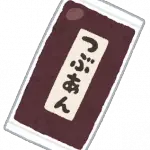
*寒天 = kanten = agar-agar- sea gelatine made from tengusa (or other seaweed)

*和三盆 = wasanbon = a type of traditional Japanese sugar
*米粉 = komeko = rice flour
*もち粉 = mochiko= sweet rice flour/powder made from glutinous rice
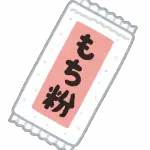
*餅 = mochi = pounded rice cake made from glutinous rice.
★ 調味料 = choumiryou = condiments
★香辛料 = koushinryou = spices (and condiments)
*塩 = shio = salt
*胡椒 = こしょう = koshou = pepper
*黒胡椒 = 黒こしょう = kuro koshou = black pepper
*白胡椒 = 白こしょう = shiro koshou = white pepper
*粒胡椒 = 粒こしょう = tsubukoshou = grains pepper
*ケチャップ= kechappu = ketchup
*マヨネーズ= mayoneizu = mayonnaise
*辛子 = からし・カラシ= karashi = mustard
*和辛子 = 和がらし/ガラシ= wagarashi = Japanese mustard
*洋辛子= 洋がらし/ガラシ= yougarashi = Western mustard
*スパイス = supaisu = spice
*香辛料 = koushinryou = spice
*山椒 =さんしょう= sanshou =Japanese pepper
*赤唐辛子 = akatougarashi = red pepper
*七味唐辛子 = shichimi tougarashi = mixture of chili pepper, sesame seed, poppy seed, yuzu peel, rape seed or shiso.
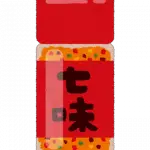
*ナツメッグ = natsumeggu = nutmeg
*味噌 =みそ= miso = fermented bean paste
*白味噌 = 白みそ= shiro miso = white miso
*赤味噌 = 赤みそ= aka miso= red miso
*合わせ味噌 = awase miso = mixture of different kinds of miso
*酒 = sake = Japanese alcoholic beverage made from fermented rice
*味醂 = みりん= mirin = a type of Japanese sweet sake which is used for cooking
*酢 = す= su = vinegar
*すし酢 = sushisu = vinegar prepared to season the rice used in sushi.
★ソース= sousu = sauce
*醤油 = しょう油 = shouyu = say sauce
*ウスターソース = usutaa sousu = Worcestershire sauce/ steak sauce
*とんかつソース= tonkatsu sousu = thick Worcestershire sauce/ steak sauce that we use for とんかつ (= tonkatsu) deep-fried pork cutlet)
*トマトピューレ = tomato pyuure = tomato puree
*トマトペースト = tomato peisuto= tomato paste
*ホールトマト = hooru tomato =(canned / bottled) whole peeled tomato
★ ハーブ= haabu= herbs
*オレガノ = oregano= oregano
*月桂樹の葉= gekkeiju no ha / ローリエ = rourie= laurel
★スープ= soupu = soup
*コンソメキューブ= konsome kyuubu/ 固形スープの素= kokei suupu no moto = Consomme cubes / soup stock cubes
*インスタントスープの素 = insutanto suupu no moto= Instant soup mix
*だし汁 = dashijiru= Japanese soup stock, broth
*だしの素 = dashinomoto = instant Japanese bouillon
![]() verb : (〜で)だしを取る= (~ de) dashi wo toru = to make broth from ~
verb : (〜で)だしを取る= (~ de) dashi wo toru = to make broth from ~
Usually Japanese だし( = dashi) soup stock is made from
↓
*かつお節 = katsuobushi= (shaved) dried bonito fish
→かつおだし ( = katsuodashi)

or
*煮干し=nibosh= small dried sardine
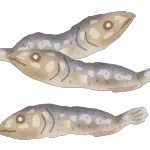
*********************
![]() To measure the ingredients:
To measure the ingredients:
verb :
![]() 計る = hakaru = to measure
計る = hakaru = to measure
![]() 量る= hakaru = to weigh
量る= hakaru = to weigh
*はかり= hakari = a scale
* 計量カップ = keiryou kappu = a measuring cup
* 計量スプーン = keiryou supuun = a measuring spoon
* 小匙 = 小さじ = kosaji = a tea spoon 5cc
* 中匙 = 中さじ = chuusaji = a medium size tea spoon 10cc
* 大匙 = 大さじ = oosaji = a table spoon 15cc
*計量カップ = keiryou kappu = measuring cup
*カップ1杯 = kappu ippai = a cup of ~ (200cc)
*半カップ= hankappu = a half cup (100 cc)
*温度計= ondokei= a thermometer
*度 = do = degree(s)
Ex. 180度= hyakuhachijuudo = 180 degrees/ 180℃
Note : Careful! In Japan we use 摂氏 ( = sesshi) Celsius ℃ not 華氏( = kashi) Fahrenheit °F
Also when you measure the ingredients, you have to convert the units.
:u:
Weight units:
*グラム = guramu = grams
*キロ= kiro = kilograms
Volume units :
*リットル= ritttoru = litter
*cc = shiishii/ ml = ミリリットル= miriritoru
*合 = gou
Ex. 一合= ichigou = 180 ml
*少々 = shoushou = a little
*半分 = hanbun = a half
*適量 = tekiryou = moderate amount
★調理器具 = chourikigu = cooking utensils
I made a kitchen related lesson before so you can study the names of basic cooking utensils, but I’ve added some more vocabulary here.
* オーブン/ 天火 = oubun / tenpi = an oven
*天板 = tenpan = a cookie sheet
* 電子レンジ = denshi renji = microwave oven
* ボウル = bouru = a bowl, a mixing bowl
* 鍋 = nabe = a pot
*まな板 = manaita= a cutting board
*泡立て器 = awadateki = a whisk
Ex. 泡立て器でかき混ぜる
= awadateki de kakimazeru
= to mix with a whisk
*クッキー型 = kuukii gata = a cookie cutter
Ex. 生地をクッキー型で抜く
= Kiji wo kukki- gata de nuku
= cut the dough with a cookie cutter
*ケーキ型 = keiki gata=a cake pan
*麺棒=めん棒 = menbou = a rolling pin
Ex. めん棒で生地を伸ばす
= menbou de kiji wo nobasu
= to roll out the dough with a rolling pin
*ラップ = rappu = cling wrap film, plastic wrap
Ex. ラップに包んで冷蔵庫で一晩寝かす
= Rappu ni tsutsunde reizouko de hitoban nekasu
= Cover it with plastic wrap and let it stand in the refrigerator over night.
!heartsippai! Basic verbs for cooking
!onpu! 準備 ( = junbi) / 下準備( = shitajunbi) = preparation
*ふるう = furuu = to sift
Ex. 粉をふるう= kona wo furuu = to sift flour
Ex. 粉ふるい機 = kona furuiki = flour sifter
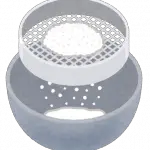
*塗る = nuru = to spread
Ex. バターを塗る = batta wo nuru = to spread butter
*溶かす = tokasu = to melt
Ex. バターを溶かす = bataa wo tokasu = to melt butter
*計る = hakaru = to measure
*量る= hakaru = to weigh
Ex. 材料を計る = zairyou wo hakaru = to measure the ingredients
*泡立てる = awadateru = to whip
Ex. 卵を泡立てる
= tamago wo awadateru
= to whip egg
Ex. 卵白をしっかり角が立つまで泡立てる
= ranpaku wo shikkari tuno ga tatsu made awadateru
= to whip egg whites until stiff peaks form
*混ぜる= mazeru = to mix
Ex. よく混ぜる = yoku mazeru = to mix well
Ex. ざっくり混ぜる = zakkuri mazeru = to mix lightly
Ex. 手で混ぜる = te de maderu = to mix something with one’s hands
Ex. かき混ぜる = kakimazeru = to stir
*和える= aeru = to mix (lightly)
*注ぐ = sosogu = to pour
*剥く= むく = muku = to peel
Ex. りんごの皮をむく = ringo no kawa wo muku = to peel an apple
*洗う = arau = to wash / to rinse
Ex. 野菜を洗う = yasai wo arau = to wash/clean vegetables
*揚げる= ageru = to deep fry
*つける = tsukeru = to soak, to dip
*つけておく= tsukete oku = to soak, to leave something in the sauce for a while
*水切りをする = mizukiri wo suru = to drain off the water
*水を切る = mizu wo kiru = to drain = to drain off the water
Ex. ざるで水を切る= to drain off the water with the strainer
* 置く/ おく = oku = to leave something
Ex. 20分置いておく = nijuppun oite okku = to leave something for 20 minutes
Note:
In cooking instructions you often see the verb ~ておく(=teoku)
to do something ahead of time, to prepare something
![]() Ex. 洗っておく = aratte oku = to wash something ahead of time
Ex. 洗っておく = aratte oku = to wash something ahead of time
*室温に戻す = Shitsuon ni modosu = to let ~ to room temperature
Ex. バターを室温に戻しておきます。
= Battaa wo shitsuon ni modoshite okimasu.
= Let butter warm to room temperature.
*寝かせる = nekaseru = to leave something for a while
Ex. 30分寝かせる
= sanjuppun nekaseru
= to leave something for 30 minutes
*こねる = koneru = to knead
*柔らかくする = yawarakaku suru = to make ~ soft, to soften ~
*湯煎にする = yusen ni kakeru = putting ~ in the bowl with hot water.
*温める = atatameru = to heat up
Ex. オーブンを250度に温める
= oubun wo nihyakugojuudo ni atatameru
= to heat the oven 250 degrees.
*冷ます= samasu = to cool off
*調理する = chouri suru = to cook ( in general)
*焼く = yaku =to bake, to fry, to roast
Ex. フライパンで焼く= furaipan de yaku = to pan-fry
Ex. 220度のオーブンで30分焼く
= Nihyaku nijuudo no oubun de sanjuppun y aku
= To cook/bake/roast in an oven at 220 degree for 30 minutes
Ex. きつね色になるまで焼く
= kitsuneiro ni naru made yaku
= to cook/roast/fry until it gets gold brown
★ 火加減 = hikagen = strengh of fire
*強火 = tsuyobi = high heat
*弱火 = yowabi= low heat
*中火 = chuubi = medium heat
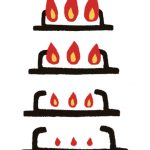
Ex. 弱火でコトコト煮る
= Yowabi de kotokoto niru
= to simmer on low heat
★水= mizu = water
*お湯 = oyu = hot water
*ぬるま湯 = nurumayu = tepid water
*熱湯 = nettou = boiled water
*沸騰させる = futtou saseru = to boil
Ex. 水を沸騰させる = mizu wo futtou saseru = to boil water
*洗う = arau = to wash
*切る = kiru = to cut / slice / dice
Ex. 材料を切る = zairyou wo kiru = to cut the ingredients
Ex. みじん切りにする = mijingiri ni suru = to chop, to cut in small pieces
Ex. ザグ切りにする = zakugiri ni suru= to cut coarsely
Ex. くし型に切る= kushigata ni kiru = to cut into wedges

*きざむ= kizamu = to chop, to mince
Ex. 細かくきざむ = komakaku kizamu = to cut fine, to cut something in small pieces
*つぶす = tsubusu= to mash, to crush
*飾り付ける = kazaritsukeru = garnish, decorate
*絞る= shiboru= to squeeze
Ex. レモンを絞る
= remon wo shiboru
= to squeeze lemon
*水を切る = mizu wo kiru = to drain off the water
Ex. ざるで水を切る
= zaru de mizu wo kiru
= to drain off the water with the strainer
*冷やす= hiyasu = to chill
*凍らせる= kooraseru = to freeze
*炒める = itameru = to fry, to saute
*ゆでる = yuderu = to cook something in boiling water
Ex. やわらかくなるまでゆでる
= yawarakaku naru made yuderu
= to boil until it gets softer
*生地 = kiji = dough
Ex. パンの生地 = pan no kiji = bread dough
*こねる = koneru = to knead
*発酵させる= hakkou saseru =to rise/ to ferment
Ex. 生地を発酵させる= kiji wo hakkou saseru = to let the dough rise
*蒸す = musu = to steam
*炊く = taku = to cook (rice)
Ex. ご飯を炊く= gohan wo taku = to cook rice
*煮る = niru = to boil (up) / to cook
Ex. とろ火で煮る= torobi de niru = to simmer over low heat
*加える = kuwaeru = to add
*入れる = ireru = to add/ to put
*割る= waru = to crack, to break
Ex. 卵を割る= tamago wo waru = to crack an egg
*(すり)おろす = (suri) orosu = to grate
Ex. チーズをおろす= chiizu wo orosu = to grate cheese
*油をひく
= abura wo hiku
= to grease
Ex. あたためたフライパンに油をひく
= Atatameta furaiipan ni abura wo hiku.
= To grease the heated pan
*火にかける
= hi ni kakeru
= to put something over a fire
*火からおろす
= hikara orosu
= to remove from the heat
*蓋/ふた/フタをする = futa wo suru = to put a lid on
Ex. 蓋/ふた/フタをして30分煮る
= futa wo shite sanjuppun niru
= to cook in a covered pot
*ひっくり返す= hikkuri kaesu =to flip
*取り出す = toridasu = to take out
*味付けする= ajitsuke suru = to season
*ふりかける= furikakeru = to sprinkle, to dust
*出す= dasu = to serve
Ex. 料理を出す = ryouri wo dasu = to serve the meal
![]() How to read recipes :
How to read recipes :
Reading recipes may be tough but here are some typical patterns.
*まず〜(し)ます
= Mazu ~ (shi)masu
= First you do ~
Ex. まず材料を計ります。
= Mazu zairyou wo hakarimasu.
= First measure the ingredients.
*次に〜(し)ます
= Tsugi ni ~ (shi)masu.
= And then do ~
Ex. 次に玉葱をみじん切りにします。
= Tsugi ni tamanegi wo mijin giri ni shimasu.
= Then chop the onions.
*〜(し)ている間に〜(し)ます
= ~ shiteiru aida ni ~(shi)masu.
= While doing ~, do ~
Ex. 冷蔵庫で冷ましている間にクリームを泡立てます。
= Reizouko de samashite iru aida ni kuriimu wo awadatemasu.
= While leaving it in the refrigerator to cool it off, whip the cream.
*〜(し)ておきます。
= ~ (shi)te okimasu
= to do something ahead of time
Ex. オーブンを温めておきます。
= Oubun wo atatamete okimasu.
= Preheat an oven.
* 〜たら出来上がりです。
= ~ tara dekiagari desu.
= When it ~, it’s done. / After you do ~, it’s done.
Ex.粉砂糖を上からかけたら出来上がりです。
= Konazatou wo ue kara kaketara dekiagari desu.
= Sprinkle powder sugar on top and it’s done.
![]() Instructions of how to eat:
Instructions of how to eat:
*冷やしてお召し上がり下さい。
= Hiyashite omeshiagari kudasai.
= Serve it/them cold (chilled)
*よく振ってお召し上がり下さい。
= Yoku futte omeshiagari kudasai.
= Shake well before serving/ Shake well for best taste.
![]() For shopping / Reading labels
For shopping / Reading labels
*缶詰 = kanzume = canned food
*瓶詰め = binzume = bottled food
*生 = nama = raw, fresh
*原材料 = gennzairyou = genzairyou = (literally) raw materials→ingredients
*賞味期限 = shoumikigen= expiration date, best when used by date
Ex. 賞味期限が過ぎる = shoumikigen ga sugiru
or賞味期限が切れる= shoumikigen ga kireru
= to expire
Note: If you are not sure how long the products last, you can ask the sales clerk,
Ex. これはどれぐらい持ちますか?
= Kore wa soregurai mochimasu ka?
= How long does it last?
![]() 保存= hozon = storing
保存= hozon = storing
*要冷蔵= youreizou = Keep refrigerated
Ex. 開封後は要冷蔵
= kaifuugo wa youreizou
= refrigerate after opening
Ex. 涼しく乾燥した場所に保存して下さい。
= Suzushiku kansou shita basho ni hozon shite kudasai.
= Store in cool and dry place.
*常温保存 = jouon hozon kanou = store at room temperature. / shelf-stable
*低脂肪= teishibou = low-fat
*冷凍食品 = reitou shokuhin = frozen food
*合成保存料 = gousei hozonryou =synthetic preservatives
*合成着色料 = gousei chakushokuryou= artificial coloring
*無添加 = mutenka = additive-free
*使用 = shiyou = use / include/ added
Ex. 合成保存料使用
= gousei hozonryou shiyou
= synthetic preservatives added
Ex. 合成着色料は一切使用しておりません。
= Gousei chakushokuryou wa issai shiyou shite orimasen.
= No artificial coloring
*食品添加物
= shokuhin tenkabutsu
= food additive
*遺伝子組み換え食品
= idenshi kumikae shokuhin
= genetically modified products
*有機栽培
= yuukisaibai
= organic/ organically-grown
*************
 マギー先生より= Maggie Sensei yori = From Maggie Sensei
マギー先生より= Maggie Sensei yori = From Maggie Sensei
私は甘いものに目がありません。 !CHECKHEART! :macarron:
= Watashi wa amai mono ni me ga arimasen.
= I have a real sweet tooth.
誰か、美味しいお菓子を作ってくれない?
= Dareka, oishii okashi wo tsukutte kurenai?
= Anybody want to make delicious sweets for me?
***
Will you be my Patron?
I appreciate your support! サポートありがとう!

29 Comments
Hi,if “Gekkeiju” means “Bay Tree” then does the same word apply for “Bay Leaf”.
In “Indo no ryori”(Indian Cuisine) this is one of the “Zairyo”(Ingredients) that is commonly used.
Thanks in advance.
Hi SK
Bay Leaf is “月桂樹の葉=げっけいじゅのは = gekkeiju no ha” or “ローリエ = rourie (from a French word “laurier”)
This really was a life saver!!!!! Thank you so much for all the information that you’ve provided here.
It would be a great help if you could tell me how to say ‘clean and devein the shrimps’.
Hello Muskaan,
Happy to hear you found this lesson informative.
‘clean and devein the shrimps’ in Japanese is エビの背わたをとる = Ebi no sewata wo toru
How could i say turn off the heat? or remove from the heat?
Hello Hannah,
turn off the heat= 火を消す= hi wo kesu
remove from the heat = 火からおろす= hi kara orosu
Hello せんせい、I would like to ask you how to say “to remove the skin”. Thank you for your efforts and hope you have a wonderful day!
Hi アマチュア
It depends on what skin you are talking about but you can say
皮を取り除く(かわをとりのぞく)
皮を剥く(かわをむく)
Hello! How would you say, Space the cookies 4 cm apart??
Hi Coco
クッキーの間を4センチ空けてください。
Sensei. How do you say the following words related to cooking.
To blanch
To sear
To julienne
To drizzle
To marinate
To whip
To whisk
To poach
To braise
Dressing/ to dress
To deglaze
OMG, OK, I will try
To blanch 湯どうしする= yudoushi suru
To sear 強火でさっと焼く = tsuyobi de satto yaku
To julienne 千切りにする = sengiri ni suru
To drizzle (〜に)たらす = ( ~ ni ) tarasu
To marinate 漬ける・マリネする = tsukeru/ marine suru
To whip (しっかり)泡立てる = (shikkari) awadateru
To whisk 泡立てる = awadateru
To poach 熱湯の中に入れる・熱湯でゆでる = nettou no naka ni ireru / nettou de yuderu
To braise 蒸し煮する = mushini suru
Dressing/ to dress If you meant to put dressing sauce on something ドレッシングをかける = doresshingu wo kakeru
To deglaze (鍋・フライパンに) 〜を入れてソースを作る = ( nabe/ furaipan ni) ~ wo irete soosu wo tsukuru
Thanks a lot sensei. I’ve been working at a restaurant and that helps me a lot. ありがとう!
You’re welcome! 💕
serves (how many people)
set aside
let rest
blender
mixer
fold in
Good, I should cover those, huh?
serves (how many people) number + 人分 (= ninbun)
set aside 置いておく
For blender and mixer I already covered in this lesson 台所 lesson.
→ミキサー
let rest = 寝かせる= neakaseru / 寝かせておく= nekasete ku
Fold in (切るように)混ぜ込む (= kiru you ni) mazekomu ・切るようにさっくり混ぜる ( = kiru you ni sakkuri mazeru)
Found a couple of typos:
Ex. よく混ぜる = yokju mazeru = to mix well <– Yoku mazeru??
*冷やしてお召し上がり下さい。= ihyashite omeshiagari kudasai. <– Hiyashite??
I think it lacks one expression:
– (after finishing something) distribute X in each of the dishes . This is very common in recipes.
Thanks for the lesson :-)
Thank you for spotting the typos. I fixed them. ありがとう!
what’s the difference between 揚げる、焼く and 炒める?
also 沸騰させる and 水を沸かす?^^
@yrz
揚げる deep fry (with lots of oil) 炒める fry or saute (less oil than 揚げる)
焼く toast, broil, bake..(general)
水を沸かす= to boil water
沸騰させる= to heat/bring ~ to boil
@yrz
揚げる deep fry (with lots of oil) 炒める fry or saute (less oil than 揚げる)
焼く toast, broil, bake..(general)
水を沸かす= to boil water
沸騰させる= to heat/bring ~ to boil
元気です!使用期限ですね、ありがとうございましたマギー先生!
あともう一つ気になる事があるんですが、「…. Doesn’t count」は日本語で何と言いますか?例えば、”Potatos don’t count as one of your 5 a-day vegetables”, “Watching japanese anime doesn’t count as real study”.
A: I love video games!
B: Like what?
A: Candy crush on my phone!
B: Mobile game’s don’t count (as real video games).
@Lava
元気でよかった〜♪
doesn’t countは「〜は含まれない」「〜は数に入れない」「〜は数に含まれない」「〜は〜〜〜に入らない」「〜は別」などいろいろな言い方があります。その例文でどれを使うか微妙に変わります。
日本のアニメを見ることは本当の勉強には入らない。
日本のアニメを見ることは本当の勉強とは別だ。
日本のアニメを見ることは本当の勉強には含まれない。
***
〜は別です!・(casual)〜は別だよ。
〜は数に入(はい)りません。・(casual)〜は数に入らないよ。etc.
こんにちはマギー先生!
賞味期限について質問があるんですが、食材以外の物にはなんの言葉が使われていますか?例えば化粧品とかスキンケアの商品とか車とか。
化粧品に賞味期限を使ってしまったことがあって笑われたんです~_~;
@Lava
こんにちは〜Lava!! 元気でしたか?
そうですね、賞味期限や消費期限は主に食品に使うので
化粧品やスキンケア商品には”使用期限”を使いますよ。
This is so AWSOME! What a great explanation. I love all the foods you have written. You are awesome.
@Maya
Hi Maya!
Thank you for the nice comment!
I bet you love cooking (or food!) like I do. :)
What a helpful lesson!! Thank you so much!
@Eva
Hello Eva!!
I am happy to hear you find this lesson helpful!!
Oishii mono ippai tsukutte ne!